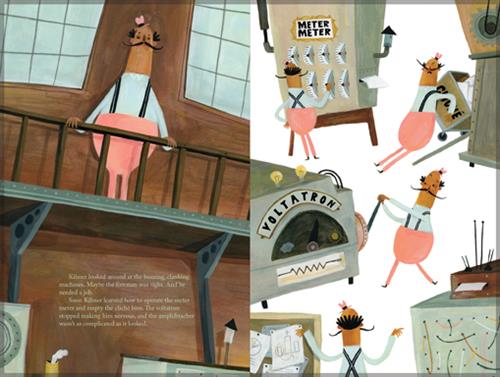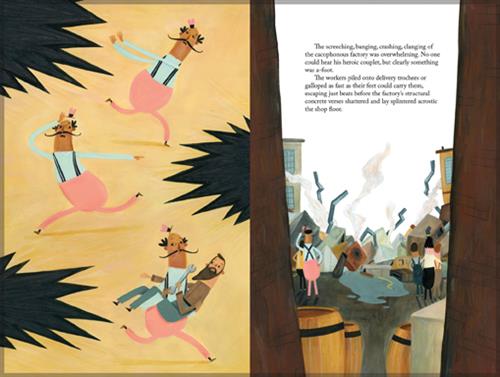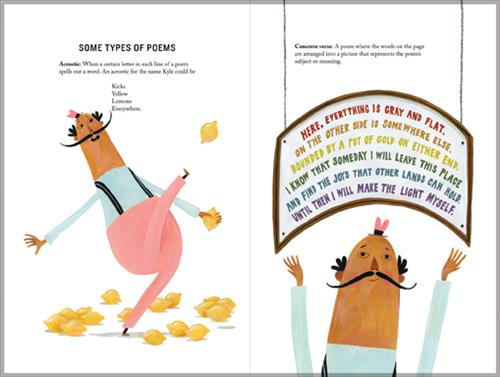A funny story, full of wordplay, brings poetry alive as never before!
Kilmer Watts makes his living teaching piano lessons, but when automatic pianos arrive in town, he realizes he’s out of a job. He spots a “Help Wanted” sign at the poem factory and decides to investigate — he’s always been curious about how poems are made.
The foreman explains that machines and assembly lines are used for poetry these days. So Kilmer learns how to operate the “meter meter” and empty the “cliché bins.” He assembles a poem by picking out a rhyme scheme, sprinkling in some similes and adding alliteration.
But one day the machines malfunction, and there is a dramatic explosion at the poem factory. How will poetry ever survive?
Kyle Lukoff’s funny story, rich in wordplay, is complemented by Mark Hoffmann’s lively, quirky art. The backmatter includes definitions of poetic feet, types of poems (with illustrated examples) and a glossary of other terms. An author’s note explains the inspiration for the story.
Key Text Features
definitions
glossary
author's note
Correlates to the Common Core State Standards in English Language Arts:
CCSS.ELA-LITERACY.RL.2.4
Describe how words and phrases (e.g., regular beats, alliteration, rhymes, repeated lines) supply rhythm and meaning in a story, poem, or song.
A funny story, full of wordplay, brings poetry alive as never before!
Kilmer Watts makes his living teaching piano lessons, but when automatic pianos arrive in town, he realizes he’s out of a job. He spots a “Help Wanted” sign at the poem factory and decides to investigate — he’s always been curious about how poems are made.
The foreman explains that machines and assembly lines are used for poetry these days. So Kilmer learns how to operate the “meter meter” and empty the “cliché bins.” He assembles a poem by picking out a rhyme scheme, sprinkling in some similes and adding alliteration.
But one day the machines malfunction, and there is a dramatic explosion at the poem factory. How will poetry ever survive?
Kyle Lukoff’s funny story, rich in wordplay, is complemented by Mark Hoffmann’s lively, quirky art. The backmatter includes definitions of poetic feet, types of poems (with illustrated examples) and a glossary of other terms. An author’s note explains the inspiration for the story.
Key Text Features
definitions
glossary
author's note
Correlates to the Common Core State Standards in English Language Arts:
CCSS.ELA-LITERACY.RL.2.4
Describe how words and phrases (e.g., regular beats, alliteration, rhymes, repeated lines) supply rhythm and meaning in a story, poem, or song.
| Published By | Groundwood Books Ltd — Apr 1, 2020 |
| Specifications | 44 pages | 7 in x 10.5 in |
| Keywords | poetry; rhymes; new experiences; elements of poetry; verse; rhymes and wordplay; humorous stories; adaptability; figurative language; rhyme; metaphors; simile; imagery; hyperbole; alliteration; onomatopoeia; writing workshop; writing poetry; summarizing; Common Core Aligned; CC Literature Craft and Structure; kindergarten; grade 1; grade 2; grade 3; grade 4; picture book; definitions; glossary; author's note; |
| Written By |
KYLE LUKOFF has worked at the intersection of books and people for more than half his life, first as a bookseller and later as a school librarian, reviewer, awards juror and contributor to professional publications. His first picture book, A Storytelling of Ravens, illustrated by Natalie Nelson, received two starred reviews and his second, When Aidan Became a Brother was described as “joyful and affirming” in a Kirkus starred review and has received three other starred reviews. A confirmed bachelor, Kyle lives in a Brooklyn apartment filled with books. |
| Illustrated by |
MARK HOFFMANN is an author/illustrator of children’s books, editorial illustrator and artist who has won many awards for his illustrations. He is also a professor at Montserrat College of Art. Mark’s picture books include Explosion at the Poem Factory by Kyle Lukoff; The Note Who Faced the Music by Lindsay Bonilla; Soren’s Seventh Song by Dave Eggers (starred reviews from Publishers Weekly and Booklist) and Dirt Cheap. Mark lives in southern New Hampshire with his family, two cats and two dogs.
|
| Written By |
|
KYLE LUKOFF has worked at the intersection of books and people for more than half his life, first as a bookseller and later as a school librarian, reviewer, awards juror and contributor to professional publications. His first picture book, A Storytelling of Ravens, illustrated by Natalie Nelson, received two starred reviews and his second, When Aidan Became a Brother was described as “joyful and affirming” in a Kirkus starred review and has received three other starred reviews. A confirmed bachelor, Kyle lives in a Brooklyn apartment filled with books. |
| Illustrated by |
|
MARK HOFFMANN is an author/illustrator of children’s books, editorial illustrator and artist who has won many awards for his illustrations. He is also a professor at Montserrat College of Art. Mark’s picture books include Explosion at the Poem Factory by Kyle Lukoff; The Note Who Faced the Music by Lindsay Bonilla; Soren’s Seventh Song by Dave Eggers (starred reviews from Publishers Weekly and Booklist) and Dirt Cheap. Mark lives in southern New Hampshire with his family, two cats and two dogs.
|
| Audience | ages 6 to 9 / grades 1 to 4 |
| Reading Levels |
Guided Reading Y
Fountas & Pinnel Text Level Y |
| Key Text Features | definitions; glossary; author's note |
| Common Core | CCSS.ELA-LITERACY.RL.2.4 |
“Liberal use of terms such as epithalmium and enjambment, both defined at book’s end, will draw precocious kids as well as adult poetry lovers to this friendly introduction to poetry and poetics.” — Publisher's Weekly
“Hoffmann's playfully expressive double-page illustrations… heighten Lukoff's guffaws… Lukoff's sophisticated silliness hits the sweet spot for lovers of wordplay.” — Kirkus Reviews
“The off-kilter angles and beanshaped personalities in Mark Hoffmann’s pictures add to the madcappery of a story that, with a little concentration (and the interpretive help of an adult), will be a primer on poetic forms and styles.” — The Wall Street Journal
“Readers who love words, and especially those who love poetry, will enjoy Explosion at the Poem Factory.” — Winnipeg Free Press




